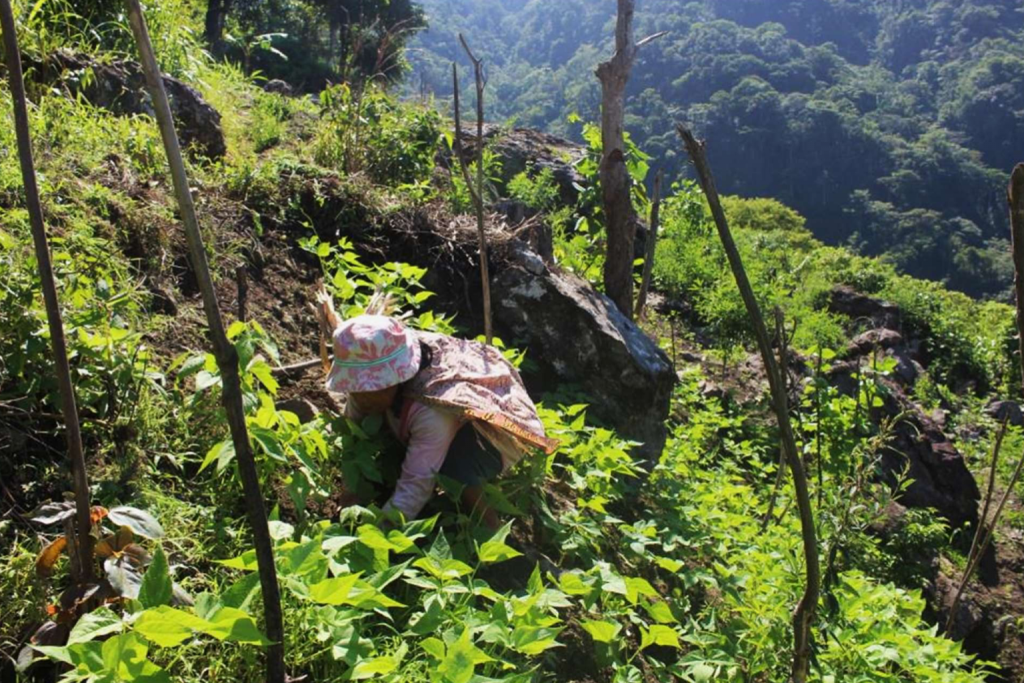With the objective of documenting environmentally sound and detrimental practices in the farming of swiddens – known as kaingin in most parts of Luzon and uma in Northern Luzon – we conducted interviews with key informants and case respondents, and did some photo and video documentation in two sample barangay within the Kalinga culture area: Gawaan in the municipality of Balbalan and Limos in the municipality of Pinukpuk. We had originally targeted the villages of Mabaca in Balbalan and Apatan in Pinukpuk. But at the time we embarked on our project, entry into these barangay was restricted by the military. Entry into Gawaan and Limos was easier. We later realized, though, that Limos was not the ideal site for our research: not all the elements we wanted to probe were present in this village.
Our documentation work was supposed to be followed by meetings for the enrichment and validation of our data and findings, and the discussion of actions that the communities and their local governments could take to improve policy and practice related to uma. But because of the Covid 19 pandemic, we had to cancel the meetings, which we had targeted to involve up to 70 persons each. We could instead return our findings to the communities through small-group discussions that would be facilitated by staff who were residents of Gawaan and Limos. Afterwards, we can produce and disseminate reading materials as the main form of our education and information work.
Our findings are summarized below.
Historical data are derived primarily from our key informant interviews but were checked against published material listed at the end of this report. Additional data to supplement those we gathered in Limos are derived from the field notes of the Secretariat of APIT TAKO, the Alliance of Peasants in the Cordillera.

Background
The kaingin, uma, or swidden is a much maligned type of farm because it is created by clearing and burning off forest. In traditional societies, however, the swidden farm is but part of a comprehensive system of land use in which people strive to maintain balance between providing for their subsistence in the short term and conserving their natural resources for the long term. The forest is especially important in the traditional land use system of the Kalinga, who engage not only in swidden farming but also in the cultivation of irrigated rice terraces, and are keenly aware of the forest’s role in water catchment and retention.
But even before they developed wet-rice terraces, the Kalinga already avoided the overutilization of forestland for swidden farming. Like most swidden farmers in traditional societies, they practiced the rotational shifting cultivation of forestlands.
Within the defined roaming areas of the “tribe” they belonged to, a Kalinga family selected a small section of forest, usually less than a hectare in size. The members of the family cleared it and planted it to a rich diversity of crops. Originally, the primary crops were taro and rice,
and the secondary crops were numerous types of legumes. Later, sweet potato, yam, and maize were added. Banana and sugarcane were grown in selected corners of the swidden.
After harvesting their crops over a period of several months, the swidden farmers let the land lie fallow, to be reclaimed by the forest. They would not return to it until five to 20 years had gone by. In the meantime, they would wait for a bird of omen to guide them to another small section of forest within their tribe’s territory, clear and farm it, fallow it, and so on.
Some sections of forest would not be available for farming because these were regarded as hunting grounds and sources of wild food, or because the spirits of the forest had made it known to the tribe that these were off-limits. Other sections would not be available because these belonged to another tribe. Given the constraints, a family would eventually return to the section of forest from which they had started.
With the establishment of wet-rice cultivation – during the second half of the 19th century in northern Kalinga, earlier in southern Kalinga – the sourcing of irrigation became all- important, and with it the delineation and protection of forests as “watersheds”. These watersheds became strictly off-limits to both swidden farming and rice terrace building.
As population increased, and with this the need to produce food, it would have been logical for the Kalinga to expand their agricultural lands, clearing more forests to make way for swiddens and wet-rice terraces. Instead, they simply intensified their exploitation of lands already used as swidden sites: they shortened the fallow periods for these sites to only three years.
With climate change, however, Kalinga communities face another problem: they are finding it increasingly difficult to predict the availability of both rainfall and sunlight for growing rice on slopes that hold no ponds for capturing both water and solar radiation. The community of Gawaan has coped by buying rice using cash they have raised through diversifying their swidden crops to accommodate marketable vegetables, putting some of their labor power on the market, and engaging in small-scale gold mining either in Gaang within the municipality of Balbalan itself or in Buneg within the adjacent municipality of Conner, Apayao. The community of Limos, however, has coped in a different way. Like most other Kalinga who live in the municipality of Pinukpuk, most people in Limos have given up traditional swidden cultivation, shifting to the production of the cash crop Bacillus thuringensis (Bt) corn.
DOWNLOAD THE FULL REPORT HERE: KAINGIN (SWIDDEN) RESEARCH REPORT

